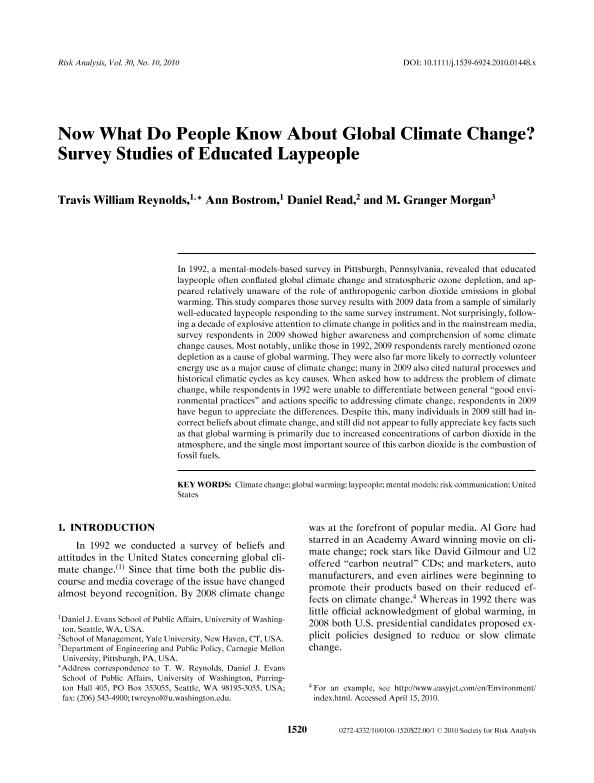Now what do people know about global climate change? : survey studies of educated laypeople

Contenido multimedia no disponible por derechos de autor o por acceso restringido. Contacte con la institución para más información.
| Tag | 1 | 2 | Value |
|---|---|---|---|
| LDR | 00000cab a2200000 4500 | ||
| 001 | MAP20100092361 | ||
| 003 | MAP | ||
| 005 | 20220911212154.0 | ||
| 008 | 101102e20101001esp|||p |0|||b|spa d | ||
| 040 | $aMAP$bspa$dMAP | ||
| 084 | $a7 | ||
| 245 | 1 | 0 | $aNow what do people know about global climate change?$b: survey studies of educated laypeople$cTravis William Reynolds... [et al.] |
| 520 | $aIn 1992, a mental-models-based survey in Pittsburgh, Pennsylvania, revealed that educated laypeople often conflated global climate change and stratospheric ozone depletion, and appeared relatively unaware of the role of anthropogenic carbon dioxide emissions in global warming. This study compares those survey results with 2009 data from a sample of similarly well-educated laypeople responding to the same survey instrument. Not surprisingly, following a decade of explosive attention to climate change in politics and in the mainstream media, survey respondents in 2009 showed higher awareness and comprehension of some climate change causes. Most notably, unlike those in 1992, 2009 respondents rarely mentioned ozone depletion as a cause of global warming. They were also far more likely to correctly volunteer energy use as a major cause of climate change; many in 2009 also cited natural processes and historical climatic cycles as key causes. When asked how to address the problem of climate change, while respondents in 1992 were unable to differentiate between general good environmental practices and actions specific to addressing climate change, respondents in 2009 have begun to appreciate the differences. Despite this, many individuals in 2009 still had incorrect beliefs about climate change, and still did not appear to fully appreciate key facts such as that global warming is primarily due to increased concentrations of carbon dioxide in the atmosphere, and the single most important source of this carbon dioxide is the combustion of fossil fuels. | ||
| 650 | 1 | $0MAPA20080588953$aAnálisis de riesgos | |
| 650 | 1 | $0MAPA20080574932$aCambio climático | |
| 650 | 1 | $0MAPA20080602871$aPercepción del riesgo | |
| 650 | 1 | $0MAPA20080578848$aAnálisis de datos | |
| 650 | 1 | $0MAPA20080612009$aPolítica medioambiental | |
| 650 | 1 | $0MAPA20080624804$aProtección del medio ambiente | |
| 650 | 1 | $0MAPA20080550592$aEncuestas | |
| 651 | 1 | $0MAPA20080638337$aEstados Unidos | |
| 773 | 0 | $wMAP20077000345$tRisk analysis : an international journal$dMcLean, Virginia : Society for Risk Analysis, 1987-2015$x0272-4332$g01/10/2010 Tomo 30 Número 10 - 2010 , p. 1520-1538 |

